|
|
||||||||||||||||||||||||
| On this page I'm going to report my progress with growing potato vines, and producing tubers, starting with true seed.
The nature of the potato flower and seed is such that the sexual pollination produces seed with very different features, even if no cross-pollination of a different cultivar is allowed. This fact explains why farmers prefer to "clone" |
||||||||||||||||||||||||
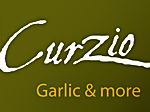 |
||||||||||||||||||||||||
| potato tubers, that is replant the tubers, rather than start vines with true seed (TPS). Starting vines with TPS is a gamble ... there is no way to tell if the tubers you will find at the end of the season have the same features of the mother plant.
No time to grow TPS in 2012 ... in 2011 I have been able to grow tubers from Black Shetland and Blossom, Blue Tomcat, Round Blue Andean. For 2013 I'm planning to grow out Morada Ojuda and Dheera.
|
||||||||||||||||||||||||
|
Many thanks to Jeff Baas, a professional videographer, who donated his time to document the Kenosha Potato Project in the summer of 2012. See for yourself what I learned about growing potato during a season of extreme drought, without access to water for irrigation. The video runs for a full hour, starting in June and ending with the harvesting of late varieties in October. About half way [31 min] I show you seed berries of the variety Dheera. Seed berries produce potato botanical seed [aka TPS]. Growing potato from seed produces new tuber varieties.
|
||||||||||||||||||||||||
| This page has been updated May 13, 2010 with pictures of TPS started on Feb 26 - please scroll to the bottom to see the latest updates. Plus, on June 15 I'm glad to report that I have found several TPS seedlings in the garden. I was inspired to experiment with TPS by Michael Pollan's book "The Botany of Desire". In his book Michael suggests to always let potato vines go to flower and develop the fruit .. eventually the seed fallen on the ground will germinate and create "natural" new varieties. After trying for several years, finally I have some that have self-germinated.
At the end of the 2010 season I'll add pictures of tubers grown from self-germinated TPS - these are vines that I recognize in my garden area where potato were growing last year - you can clearly tell if any potato vine has a tuber in the ground versus a vine that has germinated from seed. I have records of which varieties were growing where this self-germinated vines are growing now .. but the parentage will be very difficult to ensure.
|
||||||||||||||||||||||||
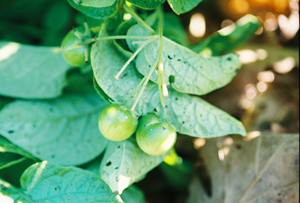 |
Alaska Red True Seed
I have been growing potatoes since 2002 but in 2008 for the first time I found seed pods - what a wonderful surprise. Well, in the spring 2008 I have started the Kenosha Potato Project, and I have planted several varieties that have set true seed pods (about 10 out of 30 cultivars- see list below). |
|||||||||||||||||||||||
| Perhaps the plants that are setting true seed pods are telling me that they are very happy with my biodynamically improved soil. | ||||||||||||||||||||||||
| Not all cultivars will produce True Seed for you!
According to Will Bonsall (the original SSE potato collection curator) vines will produce seed pods depending on soil quality, day length and other unknown factors. In my opinion the production of seed pods is the affirmation that the selection of a particular cultivar is correct for a particular garden. For the opposite, if the vines don't produce seed, perhaps they are NOT supposed to be grown in your region. The seed pods look like cherry tomatoes and contain between 100 and 250 seeds similar to a tomato. The seed is removed from the pods in the kitchen with a food processor in a bowl of water. The seed will drop to the bottom of the bowl, dried and stored like tomato seed. Storage in the freezer for a few weeks helps to accelerate the natural dormancy period.
|
||||||||||||||||||||||||
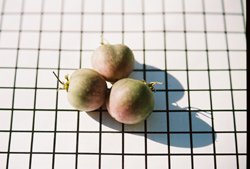 |
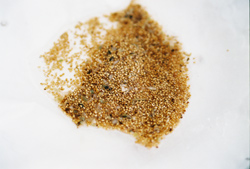 |
|||||||||||||||||||||||
| Three seed pods of Blue of Sweden - on the half inch background grid you observe a pod size of almost one inch across. These are the largest seed pods of my collection, and the only pods that turn purple - all other seed pods range from light green to dark green. | This is the seed I have harvested from a few dozen pods harvested from Russian Blue potato vines. | |||||||||||||||||||||||
| In the winter/spring start the potato seed like you would start a tomato seed and transplant the vines in the garden after the danger of frost has passed. If you have a green house you can start the seed earlier and grow the vines under lights ... small mini tubers are formed on the tiny vines ... potato vines can then be started outdoors by planting the mini tubers. (See seed starting reports at the bottom of this page). | ||||||||||||||||||||||||
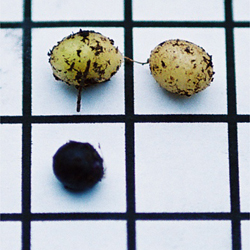 |
||||||||||||||||||||||||
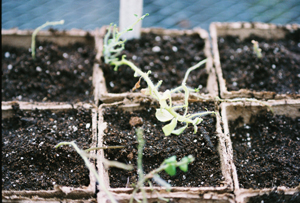 |
||||||||||||||||||||||||
| On a half inch background pattern observe mini tubers grown from seed started in December. | In addition to the mini tubers, potato vine seedlings (started from TPS in December) are repotted in April for transplating outdoors in June. | |||||||||||||||||||||||
| If you start your seed too late in the spring, instead of producing mini tubers to start vines in the field, you may be able to transplant the vine that sprouted indoor under growing lights (like you transplant tomato vines). I'll try both methods and will post result reports at the bottom of this page.
The picture above shows mini tubers harvested in April while I was repotting the seedlings. On the mini tubers I could observe tiny sprouting eyes. I guess that these mini tubers could be planted in the garden like any potato seed tubers. I decided to play it safer and instead put them in peat moss pots under growing lights to be transplanted in the garden in June.
|
||||||||||||||||||||||||
| If you want to produce a lot of potato seed pods you can graft a vine started from seed onto a tomato seedling. The tomato seedling provides the root system (which obviously will NOT produce any tubers) and the potato vine will produce a large number of flowers and seed pods. | ||||||||||||||||||||||||
| Breeding and NAMING new varieties
Even if you grow only one variety of potato in your garden (even if you grow only one vine) the "autotetraploidic" nature of the potato ... wow, this is really way over my head ... but basically XX + XY chromosomes divide and recombine in 16 different possibilities - therefore each seed of the potential 250 contained in the seed pod may be one of the 16 combinations. Now, there may be potato cultivars out there that are stabilized to the point that all 16 variations are very similar and impossible to tell apart and therefore all these tubers could be named as the mother (this may be the case for the Ukrainian cultivar Ilona). But if you, like me, grow many cultivars and allow cross pollination, well you know the mother ... but likely will not be able to determine the father of your new cultivar. Each vine may develop very different tubers. One plant may produce tubers that you want to grow out (multiply with the traditional method of cloning tubers), make sure you NAME that tuber with a new name. Will Bonsall tells me that he has mailed true seed to SSE members and found these members reoffering tubers with the same name. This creates a lot of confusion! Very likely the new cultivars are quite different even if they share the majority of the DNA of the mother plant. |
||||||||||||||||||||||||
| This page is linked to the Kenosha Potato Catalog
Click here to review the catalog. The production of true seed for different cultivars is disclosed in the catalog - but here we are listing the names of the cultivars that are reported to develop true seed pods (TPS) in SE Wisconsin - Note: the same cultivars in a different geographic area may not yield seed pods! You can order seed (TPS) by becoming a member of Seed Saver Exchange or you can trade true potato seed with me on www.davesgarden.com - on DG you will only find TPS available for trade if I have enough. Pictures of seed pods - KPP members upload pictures of seed pods on the DG web site www.davesgarden.com - Select Guides and Info - Click on Potato crop - find the cultivar name (but be aware than DG does not allow individual synonym listings and therefore All Blue, Blue of Sweden, Russian Blue are all listed with the name Russian Blue).
Click here to review other cultivars' seed listed by Curzio with SSE I have 300+ varieties of potato planted in 2012 + more that have over-wintered and have germinated (most are heritage cultivars with very few modern) and keep adding names to the list above as I see flowers develop into seed pods (TPS) - also note I'm a beekeeper. It is likely that bee activity in my garden increases cross pollination and development of seed pods. I DO NOT COLLECT TPS FROM ALL THESE VARIETIES EVERY YEAR. TPS seed can be ordered through a membership with Seed Saver Exchange. |
||||||||||||||||||||||||
| DNA fingerprinting - cultivars with same names
Russian Blue, All Blue and Congo may be all and the same cultivar, so Blue of Sweden. The Canadian Dept of Agriculture (Agri-Canada) has performed DNA fingerprinting to determine that these cultivars are one and the same. On the other hand the Canadian Agency keeps growing these cultivars separately (and keep the different names) because even genetic fingerprinting is not the final response. Even if most chromosomes are identical, there may be factors that science is not able to detect yet, that make these cultivars different. Also you have to consider that tubers grown in different regions, different continets, may have further developed genetically with very small variancies that are hard to detect. TPS of blue fleshed cultivars At this time I'm not able to find the source of this information, but I recall reading in a newsletter published by Agri-Canada that the "Congo Group" cultivars are not viable as male chromosome, therefore the cultivar can only be used as the female half of any cross. If that is true, I shall not hope to find blue fleshed tubers grown from any TPS harvested from "not-blue-fleshed" vines. All TPS that you can order from me through SSE is not produced in laboratory. My field grown crosses are the result of nature at work, including a few hives of bees. I'm very curious to start growing vines from this seed and look forward to report back the results. UW reports that dark flesh potato cultivars may contain antioxidant levels up to 90 times greater than white flesh cultivars. |
||||||||||||||||||||||||
| TPS - True Potato Seed - starting report
Before you start seed you need to ensure that the proper dormancy period has elapsed. Freezing seed for a few weeks helps to accelerate the dormancy. As reported on top of this page, you can either plan to start the seed indoor in March/April and transplant to the garden when all risk of frost has passed. Or you can start much sooner and grow the vines out under growing lights indoor. The process should yield tiny tubers (tuberlets) which are harvested and planted in the garden to germinate. I'll test both methods and will link the result reports here!
2010 TPS started on February 26 in Jiffy plugs - about 90% germination rate - except for Russian Blue (0% germination) but Blue of Sweden - which may be identical to Russian Blue - has 100% germination rate of 2008 TPS in 2010. Also interesting - Blue Victor - harvested green pods in September 2009 and kept in paper bag through the winter. In February I've extracted TPS from the pods without drying it, nor freezing it - germination seems a little slower, but March 9th (10 days after starting) it's looking good. Last year I have transplated the seedlings too late into 3x3 pots ... this year I have done it after 3-4 weeks from starting the seed. See the pictures ... and come back to follow the leaf evolution. These pictures were taken on April 2nd .... I guess that best time for transplanting in the garden will be mid to end of May. The seedling need to be protected from frost!!! Notice the pictures are organized by how healthy the seedling look to me at this point:
|
||||||||||||||||||||||||
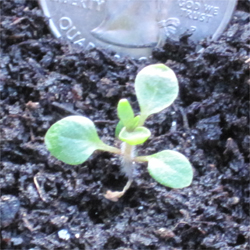 |
||||||||||||||||||||||||
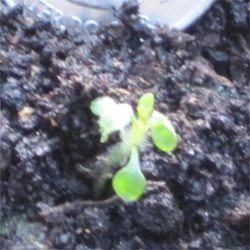 |
||||||||||||||||||||||||
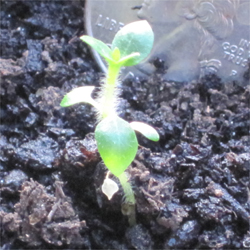 |
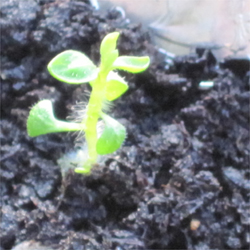 |
|||||||||||||||||||||||
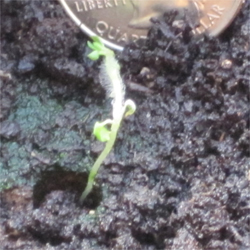 |
||||||||||||||||||||||||
| Jiffy plugs transplanted in 3x3 Jiffy pots in rich compost. Record high temps in SE Wisconsin at the end of March (60-70F) allowed for early hardening outdoors. I'm ready to move the seedlings back indoors as the temperatures drop below 50.
If you are starting late, well, I have received in-vitro seedlings as late as June. Seedling looked similar to these pictures when transplanted in the garden. They grew large vines and produced excellent tubers! |
||||||||||||||||||||||||
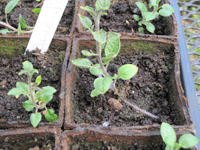 |
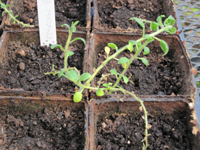 |
|||||||||||||||||||||||
| Blue Victor seedlings as developed under lights by mid May. Some have grown to almost 4" length with leaves that are larger than most tissue culture seedlings we have received in-vitro. | Riverwood seedlings - some have grown to almost 5" length - leaves are smaller than Victor Blue, but look very similar to the leave size of most tissue culture seedlings we have received in-vitro. | |||||||||||||||||||||||
| All TPS seedlings look good by mid May .. I'm planning to move outdoors for hardening in a few weeks. Best time to transplant in the garden is the first week of June.
Seedlings transplanted outdoors June 13th - Blue Victor and Riverwood in a row, while Cranberry Red and Marron Bells are planted in a potato bag.
|
||||||||||||||||||||||||
| Page updated: June, 2012
Wanted: Potato Gardeners If you'd like to participate with the Kenosha Potato Project - here are your options:
Please take the time to sign-up on the Kenosha Potato Facebook page to be kept posted on the progress. Click here to go to Facebook.
|
||||||||||||||||||||||||
|
|
||||||||||||||||||||||||